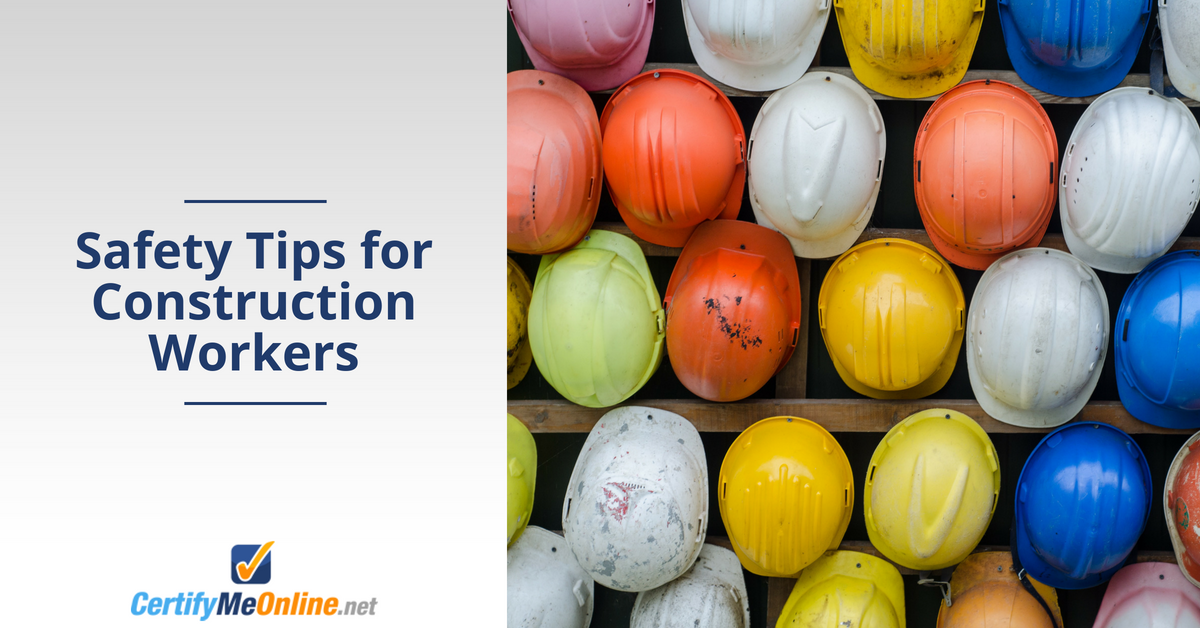Safety Measures in Construction Work
The construction industry plays a crucial role in keeping the economy growing. Construction work is an exciting and rewarding career, but without proper training it can be dangerous. According to the Bureau of Labor Statistics, there were 5,190 workplace fatalities in 2016, Almost one in five of these were in the construction industry. That’s about 80 construction workers that die on the job each month. With the right training – and by following safety tips for construction workers – many of these deaths and injuries can be avoided.
Fall Protection Safety Measures in Construction Work
Falls are one of the main causes of construction worker injuries and deaths. Employers are required to provide protection against falls whenever a worker is more than six feet off the ground. Safety measures in construction work can include guard rails, harnesses, restraining lanyards or safety nets. They need to be personally inspected before each use to be sure they’re not damaged and are working properly. Sawhorses or other barriers should be used around open holes or skylights to keep workers from falling in. Employers are required to certify that all workers have been trained to recognize and avoid fall hazards.
Scaffold Safety Tips
When it comes to safety tips for construction workers, scaffolding best practices are among the most important. More than half of all construction workers use scaffolds on the job. This includes scissor lifts, which OSHA considers to be a type of scaffold. All tools and equipment should be attached to lanyards to keep them from falling and injuring people down below. Always remove all tools and equipment at the end of a shift. Never work on scaffolds when they’re covered in mud, water or ice, even if you’re wearing non-skid boots. Don’t try to extend your reach by standing on ladders or boxes. Always be sure scaffolds are on solid footing and are at least 10 feet from power lines.
Mandatory PPE on Construction Sites
Mandatory PPE on construction sites help to prevent injuries and keep workers in compliance with OSHA regulations, so make this safety tip a priority on your jobsite. OSHA requires workers to use snug-fitting face masks and eye protection when they’re working with or around chemicals, acids, caustic liquids, or dangerous vapors or gasses. Known as personal protective equipment (PPE), they’re also required when chipping, grinding, welding, drilling or carrying out other tasks that produce flying particles. Before using them, always check eye and face protection equipment for cracks, chips or other defects – if any are found, dispose of them. Employers are required to provide their workers with these PPEs free of charge.
Hard hats should always be worn on construction sites. They help prevent being injured by blows to the head from falling or flying objects or being struck by swaying equipment. Hard hats can also prevent electrical shocks if a worker accidentally bumps into an overhead line. As with all PPE, hard hats should be inspected for dents, cracks or other signs of wear and tear. Replace them right away if they’ve been exposed to an electric shock or heavy blow. Just like eye and face protection and other PPE, employers must provide their workers with hard hats at no cost. Safety tips for construction workers don’t come any more straightforward than this.
Hazardous Substances in the Workplace
Lead, asbestos, silica and chemically treated wood are just a few of the many harmful substances often found on construction sites. Other chemicals that are sometimes present include zinc, mercury, and cadmium. Employers need to provide Material Safety Data Sheets (MSDS) for these and all other hazardous materials on site. Workers need to read and fully understand them. They also need to be trained on how to safely handle and work with these materials, including wearing eye and face protection in construction. When handling toxic or hazardous materials, protective clothing should be worn. All hazardous material containers must be clearly marked with warning labels. All spills should be contained and cleaned up immediately.
Aerial Lift Safety Tips
Aerial lifts, including truck-mounted boom cranes, cherry pickers, and aerial ladders all present unique risks. By understanding the potential hazards in play, workers can keep safe on the job. When using an aerial lift, falls, tip-overs, and electrical shocks are all possible. Collisions with overhead objects and falling items can also occur. Safety tips for construction workers recommend they wear a restraining lanyard or harness. Lifts must always stay a minimum of 10 feet from overhead power lines. Avoid exceeding the reach or load limits of your lift, as they can contribute to tip-overs and other kinds of accidents. Learning how to safely operate aerial lifts can make all the difference in preventing injuries on the job.
Why Proper Safety Training Matters
You can follow safety tips for construction workers to the letter and still find yourself involved in an accident if you haven’t been properly trained. While tips and tricks can be helpful to those working in the construction industry, they’re really meant to supplement thorough safety training. Workers are far more likely to be involved in accidents and suffer injuries when they haven’t been properly trained. That’s why OSHA requires all aerial lift operators to be trained and certified before they begin work.
CertifyMeOnline.net offers convenient, affordable training opportunities for construction professionals. No matter your background, our courses can provide the foundation you need to stay safe on the job. Safety measures in construction work can only go so far – avoiding injuries often comes down to personal accountability. Our team will ensure your business complies with OSHA standards at all times.
To learn more or to sign up for our training and certification classes, please contact us online or call us today at (602) 277-0615.

